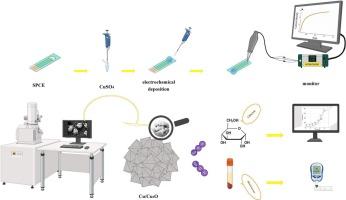Nanopyramid copper structures on screen-printed carbon electrode for high-performance non-enzymatic glucose sensing: A cost-effective and scalable approach
IF 5.4
Q1 CHEMISTRY, ANALYTICAL
引用次数: 0
Abstract
We report on the fabrication of a robust non-enzymatic glucose sensor featuring a sensing electrode composed of pyramid-shaped copper/copper oxide (Cu/Cu2O) nanostructures formed through a simple electrodeposition process on a screen-printed carbon electrode (SPCE). The fabrication of Cu/Cu2O nanostructures on the SPCE enhances the charge transfer and electrocatalytic performance of the sensor, proving advantageous for glucose sensing. Notably, this morphology contributes to electrochemical glucose determination over a wide linear range of 0.01 to 6 mM, with a sensitivity of 214.04 μA/(mM·cm2) and a low detection limit of 0.03 μM. The proposed simple approach ensures high reproducibility, stable attachment to the printed layer, and cost-effectiveness, making it well-suited for scalable production of non-enzymatic glucose sensors.

丝网印刷碳电极上的纳米金字塔铜结构用于高性能非酶法葡萄糖传感:一种具有成本效益且可扩展的方法
我们报告了一种坚固耐用的非酶葡萄糖传感器的制作过程,该传感器的传感电极由金字塔形的铜/氧化铜(Cu/Cu2O)纳米结构组成,这些纳米结构是在丝网印刷碳电极(SPCE)上通过简单的电沉积工艺形成的。在丝网印刷碳电极上制造 Cu/Cu2O 纳米结构增强了传感器的电荷转移和电催化性能,证明了其在葡萄糖传感方面的优势。值得注意的是,这种形态有助于在 0.01 至 6 mM 的宽线性范围内进行电化学葡萄糖测定,灵敏度为 214.04 μA/(mM-cm2),检测限低至 0.03 μM。所提出的简单方法确保了高度的可重复性、印刷层的稳定附着性和成本效益,非常适合于非酶葡萄糖传感器的规模化生产。
本文章由计算机程序翻译,如有差异,请以英文原文为准。
求助全文
约1分钟内获得全文
求助全文
来源期刊

Sensing and Bio-Sensing Research
Engineering-Electrical and Electronic Engineering
CiteScore
10.70
自引率
3.80%
发文量
68
审稿时长
87 days
期刊介绍:
Sensing and Bio-Sensing Research is an open access journal dedicated to the research, design, development, and application of bio-sensing and sensing technologies. The editors will accept research papers, reviews, field trials, and validation studies that are of significant relevance. These submissions should describe new concepts, enhance understanding of the field, or offer insights into the practical application, manufacturing, and commercialization of bio-sensing and sensing technologies.
The journal covers a wide range of topics, including sensing principles and mechanisms, new materials development for transducers and recognition components, fabrication technology, and various types of sensors such as optical, electrochemical, mass-sensitive, gas, biosensors, and more. It also includes environmental, process control, and biomedical applications, signal processing, chemometrics, optoelectronic, mechanical, thermal, and magnetic sensors, as well as interface electronics. Additionally, it covers sensor systems and applications, µTAS (Micro Total Analysis Systems), development of solid-state devices for transducing physical signals, and analytical devices incorporating biological materials.
 求助内容:
求助内容: 应助结果提醒方式:
应助结果提醒方式:


